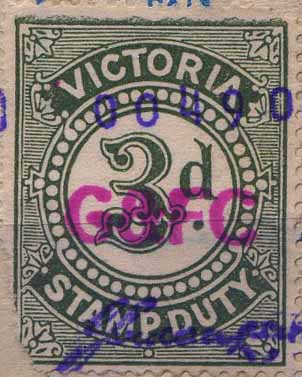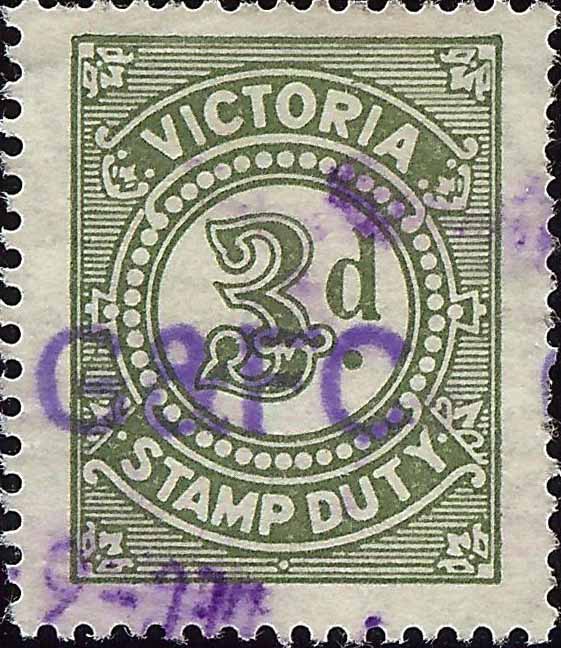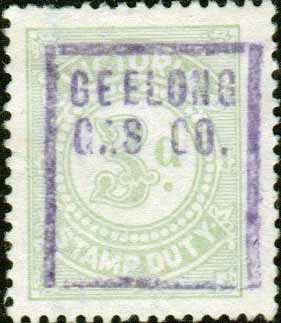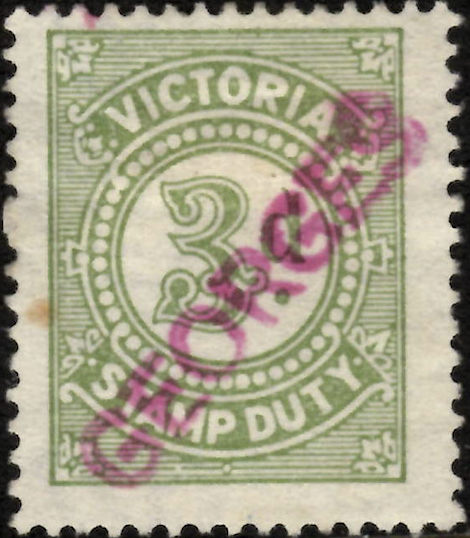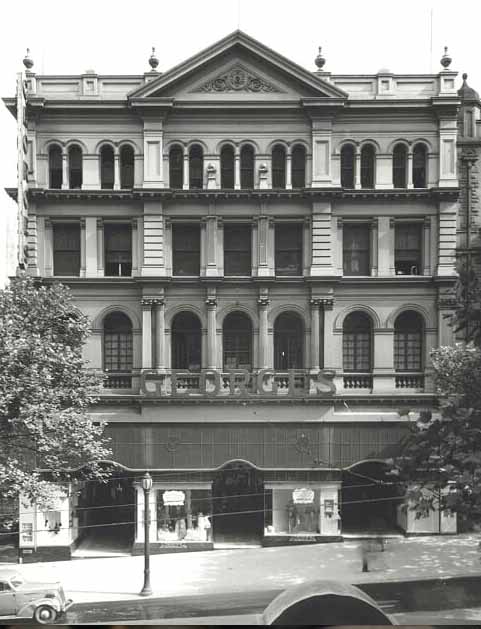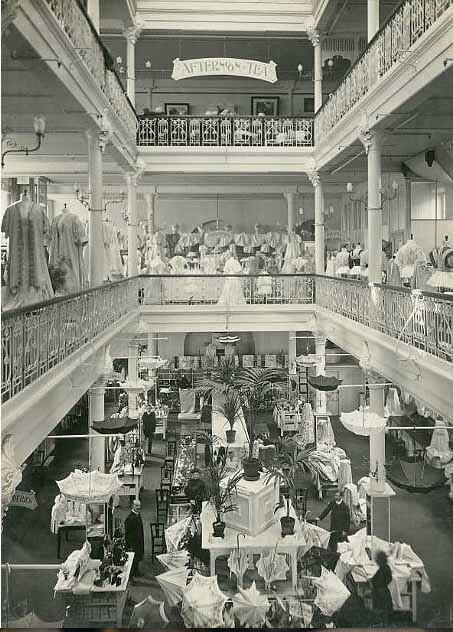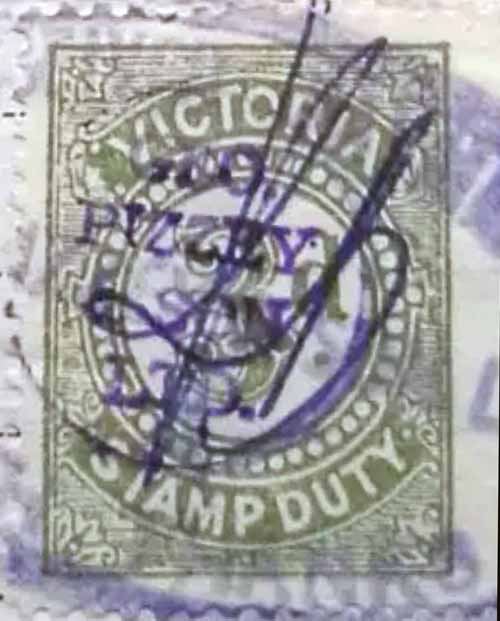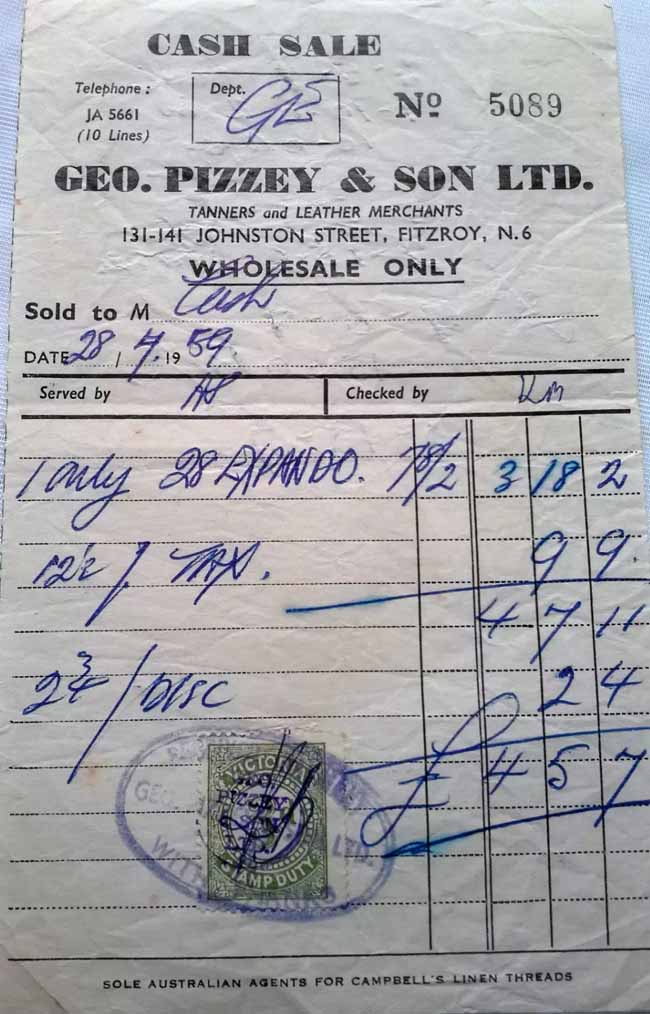|
Private Revenue Perfins of Victoria An Elsmore Coath Howard production The authors would welcome your comments additions or input into this work A B C D E F G H I J K L M N O P Q R S T U V W Y Back to Victoria 'Other' page Back to States Perfin index Back to Commercial Overprint index Section 2 - Commercial Overprints G -------------------------------------------------------- G.a User: National Bank of Australasia (uncomfirmed) Banking Address: St, Melbourne, VIC Revenue Use: 1886-1899 Series, inscribed 'STAMP DUTY' 6d Rarity Scale:
1886-1899 Series 6d R4 Background: Alexander Gibb, founder, first organiser and secretary of what would become the National Bank of Australasia, first floated the idea of a bank in a public announcement on 28 October, 1857. The National Bank of Australasia opened for business in August, 1858, in Queen Street, in the old offices of the Oriental Banking Corporation, with plans to establish branches in Sydney, Adelaide, Hobart and Mauritius (to take advantage of the sugar trade). At the end of 1858 an office of the bank opened in King William Street, Adelaide. Expansion progressed rapidly with branches opening, in 1859, in the copper mining towns of South Australia and the Victorian gold diggings towns of Bendigo, Amherst, Fryerstown, Taradale, Mt Korong, Back Creek and Sandy Creek. In May, 1859, the National Bank of Australasia moved into new banking chambers in Collins Street West, which were to remain the head office location until 1870. In 1863, a branch was established in London. The bank commenced trading in its new corporate headquarters in Collins Street East, on 19 September, 1870. The two storey stone building rose as high as five storeys with a massive circular banking chamber and a façade of eight columns and arched windows (which would be demolished in 1920 to make way for new corporate offices). Between 1872 and 1880, the National Bank of Australasia opened 22 branches and agencies in Victoria alone and by 1880 had 50 branches and agencies in South Australia. It was not until 1885 that the bank opened offices in Sydney, in Pitt Street. In April, 1893, at the height of the Depression, the bank experienced its first run on its coin (gold sovereigns) reserves and was forced to suspend payments. The bank re-opened six weeks later, having undergone a complete re-structuring and emerged as a limited liability company trading as the National Bank of Australasia Ltd. In 1900, National Bank of Australasia Ltd had offices in all states except Queensland. Mergers and amalgamations came late in the bank’s history, the first being the takeover of the Victorian bank, the Colonial Bank of Australasia (est. 1856) in 1918. The union, in 1948, of the Queensland National Bank Ltd with the National Bank of Australasia saw the National Bank of Australasia become the second largest bank in Australia. In December, 1953, the National Bank of Australasia Ltd bought 40% of Custom Credit Corp Ltd thereby providing a link with a finance company to access the developing hire purchase market. The Ballarat Banking Company was absorbed in 1955. The merger in 1982 of the National Bank of Australasia Ltd with the Commercial Banking Company of Sydney saw the creation of the National Australia Bank. Device: Handstamp Related Patterns: Nil -------------------------------------------------------- G&FC.a User: Gas & Fuel Corporation Address: 196 Flinders St, Melbourne, VIC Revenue Use: 1932 Series 2d, 3d, 3d[inverted], 3d on 2d (1960) 1966 Series 3c, 5c Rarity Scale:
1932 Series 2d R2, 3d R2, 3d[inverted o/ptint] R4, 3d on 2d R4
1966 Series 3c R3, 5c R2 Background: *The Gas and Fuel Corporation of Victoria was a government-owned monopoly supplier of household gas in Victoria, Australia. In 1951, the Victorian government took over two of the three main gas utilities in Melbourne - the Metropolitan Gas Company and the Brighton Gas Company. In 1971 the Corporation acquired the Geelong Gas Company, one of only two remaining private gas companies in Victoria at the time. One of the first tasks of the Corporation was the construction of a centralised brown coal fuelled gasification plant at Morwell, to replace the number of smaller town gas producing gasworks scattered throughout Melbourne. The plant opened in 1956 and used the German Lurgi process to produce gas that was transferred to Melbourne via a high pressure gas pipeline. The production of Syngas started in the 1950s, which is a process that converted waste gases from oil refineries to a useful energy product. In 1966, thirty percent of gas was being produced from residual oil, thirty percent from refinery gas and LPG, thirty percent from Lurgi gas, and less than ten percent by carbonization of black coal. Natural gas was discovered in Bass Strait in 1965, and a conversion program took place over a 20 month period, ending in December 1970, which required converting around one million appliances to operate on natural gas. In July 1997 the Gas and Fuel Corporation was disaggregated into three divisions: gas distributor and retail companies, a gas transmission company and an independent Market Operator, VENCorp. The distribution, retail and transmission companies were subsequently privatised by the Kennett Government, along with the State Electricity Commission of Victoria, Victoria's main electricity utility. The corporation's former headquarters, the Princes Gate Towers on Flinders Street, were then demolished to make way for the Federation Square development. Device: Handstamp Related Patterns: Nil *Wikipedia -------------------------------------------------------- GEELONG/GAS CO..a User: Geelong Gas Co Gas supplier Address: , Melbourne, VIC Revenue Use: 1932 Series 3d Rarity Scale:
1932 Series 3d R3 Background: *Geelong Gas Company was established in August, 1857 with Chas. Keenan as provisional secretary, and 10,000 partly paid shares at £5 each. S.R. Scoltock was appointed engineer. In July, 1858, the Act incorporating the company was passed by parliament and the company set about acquiring suitable land. In 1859, a site of about 6 acres, on the west side of North Geelong railway station was acquired, partly from the Geelong and Melbourne Railway Co. which also received the contract to transport materials, plant and coal for the company on its branch line. The company office was initially located at 13 Malop Street, Geelong. In February, 1860, with work on the plant, laying of gas mains and small pipes well advanced, the foundation stone including a time capsule in a large bottle, was laid by Richard Parker, chairman of the board. In May, the first gas street lamps in Geelong were lit. In early 1861, the company offices were located in Market Square (late Bank of Australasia), 12 Moorabool Street, Geelong.
In 1867, the company secretary, G.G. Whalley, using a number of aliases, absconded to New Zealand with the company funds, evaded arrest and was next seen in 1869 lecturing on ‘Commercial Immorality and Veniality’ for which he was well qualified. He drowned, in Fiji, in 1874.
In August, 1870, the company’s offices moved again, to James Henty & Co’s premises in Brougham Place on the corner of Gheringhap Street North.
For many decades in the 19th century, Geelong Gas Co. supply charges were excessively high and subject to frequent complaints; shareholders enjoyed a 10% dividend every year however. Several attempts to buy the company, ”one of the most remunerative properties of its kind” in Victoria, were rejected, stymied by the largest shareholder, the Hon. Belcher, M.L.C.
As a consequence of the high prices, gas use spread slowly, only 13% of business and street lighting in Geelong being gas powered in 1894. Excessive prices remained a feature of the company well into the 20th century.
In June, 1919, the offices and showrooms moved from Brougham Place to 90 Ryrie Street while new offices and showrooms were built at 161-163 Ryrie Street, Geelong. In early 1923, work began on rebuilding the gasworks using modern technology. A convertible debenture loan of £50,000 at 7% floated in 1926 was fully subscribed within an hour of opening.
Extensive additions to increase capacity by 50% were undertaken in early 1946, with further extensions financed by a new share issue in 1950. Extensions of supply and capacity continued throughout the 1950s and early 1960s. Coal fired gas was becoming obsolete and in 1963, Geelong gas Co. started converting hydrocarbon gases from Shell oil refinery in Corio into town gas.
In 1967, Geelong Gas Co. signed a 20 year contract to purchase recently discovered Bass Strait natural gas, requiring the construction of a pipeline from Melbourne. The conversion of domestic supply was completed in August, 1971, by which time Geelong Gas Company had ceased to trade following a successful take over by the Gas and Fuel Corporation of Victoria (June, 1971). Device: Handstamp Related Patterns: Nil *Trove, National Library of Australia *Wikipedia
1926 -------------------------------------------------------- GEORGES.a User: Georges Department Store Address: 162-168 Collins St, Melbourne, VIC Revenue Use: 1932 Series 3d Rarity Scale:
1932 Series 3d R4 Background: In 1866, brothers Joseph and Henry George opened a drapers’ business, trading as George Brothers, at 262 Smith Street, East Collingwood, which closed in 1880. In the intervening years it appears that brothers William Henry Harrison George (born 1856) and Alfred Harley George (born around 1850) learnt their trade as drapers. In February, 1880, Leonard Robinson, of L. Robinson & Co. importer and general draper, died at his home, ‘Turret House’ in Northcote. His up-market department store at 37 Collins Street East, Melbourne, (originally nos. 11-17) had on its management staff William Henry Harrison George (then aged 24) and Alfred Harley George (then aged about 30). The brothers purchased the business of L. Robinson & Co, (after a clearing sale of stock which closed 17 April) and re-opened in the same premises on Monday, 19 April, 1880, with “a large stock of first class goods, of the latest fashions”. By May, 1880, George and George (late L. Robinson & Co.) were advertising as “Importers and general drapers” and were listed in the business directory as “silk mercers and general drapers”. In 1883, George & George moved to a four storey building at 11-17 Collins Street East, near the corner of Elizabeth Street. The planned development of Block Arcade (completed 1892) and a disastrous fire on 13 September, 1889, (which completely gutted the building as well as Allan’s Music and Glen’s Music stores) saw George & George’s Department Store re-locate to the smarter, ‘Paris’ end of Collins Street, to nos. 162-168 (originally no. 89), the Federal Emporium building (built for David Mitchell in 1883, designed by architects John Grainger and Charles D’Ebro). On Wednesday, 22 July, 1908, George and George Ltd re-opened for business as Georges Pty Ltd (with W.H. George as Governing Director) in a completely re-modelled building (by architect David Purchas). Georges was one of the first stores to introduce “fast-running electric lifts” in the building; there was also a bargain basement (a novelty at the time), a fashionable café with instrumental music performed every afternoon, and ladies’ club rooms (dressing and retiring rooms, lounge, writing and appointment rooms, complimentary to all customers with a small charge for some facilities). Georges also introduced a monthly cash payment system which “has been the key to the success of the parent company George & Kersley in New Zealand” effectively a cash discount system for prompt payment of items purchased on credit. The whole of the ground floor of the old Federal Emporium building was taken out and replaced with a “magnificent array” of show windows and display cases. The interior was transformed by a huge light ell from the ground floor to the roof bringing a flood of natural light, making it easy for the ladies to match colours on the dullest day. The directors of Georges Pty Ltd were W.H. George, A.H. George and H.W. Kersley with A. Uglow as general manager; the company also trading as George & Kersley in London, Wellington and Wanganui (New Zealand). (George & Kersley are found trading in Wellington, N.Z. in 1905. The company was unknown in Victoria). Cox Brothers (Australia) Ltd, in association with Australian United Corp., acquired all the ordinary capital of Georges Holding Ltd. When Australian United Corp. went into receivership in August, 1966, Georges was sold (1967) to a new public company, Georges Australia Ltd. David Jones Ltd bought Georges Australia Ltd. in 1981. Georges’ city and suburban stores ceased trading in 1995; the iconic Collins Street building was radically altered, and re-opened as Georges on Collins with a variety of tenants. William Henry Harrison George died 1st March, 1935, in his 80th year, and was buried in Boroondara cemetery. His brother, Alfred Harley George, a director of Georges’ at the time, died 14 October, 1930, and was buried in the same plot. Device: Handstamp Related Patterns: Nil
--------------------------------------------------------
GEO./PIZZEY &/SON/LTD.a User: George Pizzey & Son Ltd. Tanners & Leather Merchants Address: 131-141 Johnstone St, Fitzroy, N.6, VIC Revenue Use: 1932 Series 3d Rarity Scale:
1932 Series 3d R4 Background: George Martin Pizzey was born in September, 1835, in Essex and arrived in Victoria during the 1850s. In 1878, George Pizzey was living in Fitzroy but it was not until late 1881 that Pizzey opened for business in his own name as a saddle, collar and harness maker at 322 (re-numbered to 346) Brunswick Street, Fitzroy, in. In the grip of the 1890s depression, he relinquished this branch of his harness and saddle manufacturing business selling the “stock in trade, goodwill, lease, fixtures and fittings” in September, 1891. Pizzey became a salesman and in 1895 sold his remaining assets as an insolvent. By 1896, he was back in business as a bootmaker at 344 Brunswick Street (his original lease having not yet expired). George Pizzey was joined by his son, Alfred Eliel Pizzey (b. 1862 in Carlton) in late 1894 and the business now traded as George Pizzey & Son. The firm resumed selling harness sets and saddlery but the chief focus was on boot making. By 1906, George Pizzey & Son business had expanded to occupy premises at 338-346 Brunswick Street, Fitzroy, with a store at 212 Swanston Street, Melbourne. By 1909, the firm was advertising as leather merchants and in 1912 received a substantial contract to supply leather to the Commonwealth Harness and Saddlery Factory, presumably from the firm’s tannery and works at 29 River Street, Richmond, which extended into 3 Clarke Street. In 1914, there was a shop in Armstrong Street, Ballarat; while the shops and spacious workrooms at 338-3342 Brunswick Street were sold in December 1914. George Pizzey & Son had opened a business in Auckland, New Zealand, which Frank Pizzey took charge of in 1916. The business became a limited liability company in 1919 being styled George Pizzey & Son Ltd with George B. Pizzey as a director. Company capital was increased by £100,00,00 in 1920. The effects of excessive competition, created by the over-development of the boot and tannery industry for the war effort, and the loss of export markets, were exacerbated by the Great Depression and the company struggled to make adequate profits to pay dividends. In 1935 however, George Pizzey & Son Ltd acquired the rival business of Hackett Bros and in 1937 that of Braithwaites. By now, company operations extended throughout Australia and New Zealand, with 75% of the business in the boot trade. The Pizzey family maintained a substantial presence in the company with A.L. Pizzey and T.G. Pizzey amongst the management team in the late 1930 to early 1940s. From 1945, George Pizzey & Son Ltd held premises at 131 Johnston Street, Fitzroy. The company was de-listed 3 June, 1968 and listed as Pizzey Ltd on the same date.
George Martin Pizzey died on 6 December, 1915, at Diamond Creek (where his son Alfred lived). Device: Handstamp Related Patterns: Nil -------------------------------------------------------- GOLDS/MORT..a User: Goldsbrough, Mort & Co Ltd Stock & Station Agents Address: 526 Burke St, Melbourne, VIC Revenue Use: CATTLE overprint: 2d, 3d, 1/,- 2/6d, 6/- Rarity Scale:
CATTLE overprint: 2d R4, 3d R4, 1/- R4, 2/6d R4, 6/- R4 Background: Refer to Goldsbrough Mort in South Australian Perfin section under G Device: Handstamp Related Patterns: Nil
-------------------------------------------------------- A B C D E F G H I J K L M N O P Q R S T U V W Y Back to Victoria 'Other' page Back to States Perfin index Back to Commercial Overprint index © copyright 2011 |

